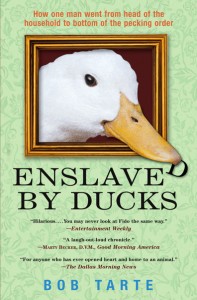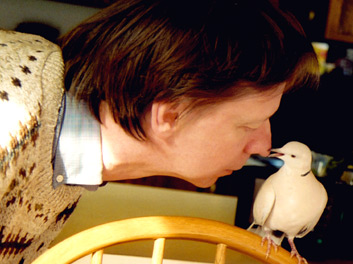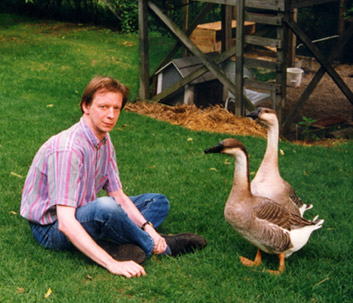Had you noticed that I had abruptly stopped giving you homework, campers? That’s not entirely coincidental: I figure that you already have distractions enough. I’m quite certain that many, if not most, of the Author! Author! community is spending this long holiday weekend (a) prepping queries to send out after Labor Day, (b) prepping requested materials to send out after Labor Day, (c) writing something fabulous and fresh, (d) revising an existing manuscript so it becomes fabulous and fresh, and/or (e) thinking, “Gee, I really ought to be doing (a) (b), (c), and/or (d) today, but the barbecue is already fired up.”
In order to amuse, enlighten, and inform those of you who are tuning in this weekend, I have blandished some very fine authors into sharing a little just-amongst-us literary advice. Yesterday, we talked about fiction. Today, we’re going to concentrate up memoir.
And not just the oft-discussed conundrum how to work up the nerve to be completely transparent on the page — no mean feat in itself — but a burning topic that I do not believe is discussed nearly enough amongst writers: narrative voice in memoir.
To succeed in grabbing the reader, a memoir’s narrative voice must also be a likable and lyrical — wait for it — narrative voice.
Was that loud BOING that just reverberated around the cosmos the sound of memoirists’ jaws bouncing off the floor? I’m not entirely astonished: in the throes of the hugely challenging task of writing one’s own life, the emotional strain of reliving events vividly enough to write about them well can easily trump the imperative to craft lovely sentences. Or even to depict yourself and your environs juicily enough for a reader to long to follow you through 300+ pages.
Let’s face it, there’s more to composing compelling memoir than having had an interesting life and being able to make it sound interesting on the page. There’s even more to it than sounding like yourself.
In order to tackle this recalcitrant problem, I tracked down one of my all-time favorite memoirists, the inimitable and hilarious Bob Tarte, author of the brilliant pet memoirs ENSLAVED BY DUCKS and FOWL WEATHER, and lobbied shamelessly for him to share his insights with the Author! Author! community. Page for page, Bob has one of the strongest memoir voices I’ve ever seen: humorous, honest, and absolutely original.
I’ve said it before, and I shall no doubt say it again: anyone seriously interested in writing humorous memoir should take a gander (so to speak) at his seemingly effortless wit. In case those of you who are not comedy writers are wondering why: there’s nothing more difficult than appearing to be spontaneously funny; it takes careful, meticulous craft.
A great comic premise isn’t a bad idea, either. Here’s the publisher’s blurb for ENSLAVED BY DUCKS:
 Enslaved By Ducks
Enslaved By Ducks
How One Man Went from Head of the Household to Bottom of the Pecking Order
When Bob Tarte left the city of Grand Rapids, Michigan for the country, he was thinking peace and quiet. He’d write his music reviews in the solitude of his rural home on the outskirts of everything.
Then he married Linda. She wanted a rabbit. How much trouble, he thought, could a bunny be?
Well, after the bunny chewed his way through the electrical wires and then hid inside the wall, Bob realized that he had been outwitted. But that was just the beginning. There were parrots, more rabbits, then ducks and African geese. The orphaned turkeys stranded on a nearby road. The abandoned starlings. The sad duck for sale for 25 cents.
Bob suddenly found himself constructing pens, cages, barriers, buying feed, clearing duck waste, spoonfeeding at mealtime. One day he realized that he no longer had a life of quiet serenity, but that he’d become a servant to a relentlessly demanding family: Stanley Sue, a gender-switching African grey parrot; Hector, a cantankerous shoulder-sitting Muscovy duck; Howard, an amorous ring-neck dove; and a motley crew of others. Somehow, against every instinct in him, Bob had unwittingly become their slave.
He read all the classic animal books — The Parrot Who Owns Me, The Dog who Rescues Cats, Arnie the Darling Starling, That Quail Robert, The Cat Who Came for Christmas — about the joys of animals, the touching moments. But none revealed what it was really like to live with an unruly menagerie.
Bob Tarte’s witty account reveals the truth of animal ownership: who really owns who, the complicated logistics of accommodating many species under one roof, the intricate routines that evolve, and ultimately, the distinct and insistent personalities of every animal in the house – and on its perimeter. Writing as someone who’s been ambushed by the way in which animals — even cranky ones — can wend their way into one’s heart, Bob Tarte is James Herriott by way of Bill Bryson.
Nor does Bob’s comic genius stop there. FOWL WEATHER was one of NPR’s Nancy Pearl’s Under-the-Radar Books for January 2008. Quoth Dame Nancy: “If you’re longing for a book that will make you laugh out loud, then run, don’t walk, to the nearest library or bookstore and pick up a copy of Bob Tarte’s Fowl Weather.”
Before you lose yourself in daydreaming about receiving a review like that, cast your eyes over the blurb:
 Fowl Weather
Fowl Weather
How Thirty-Nine Animals and a Sock Monkey Took Over My Life
Bob Tarte’s second book, Fowl Weather, returns us to the Michigan house where pandemonium is the governing principle, and where 39 animals rule the roost. But as things seem to spiral out of control, as his parents age and his mother’s grasp on reality loosens as she battles Alzheimer’s disease, Bob unexpectedly finds support from the gaggle of animals around him. They provide, in their irrational fashion, models for how to live.
It is their alien presences, their sense of humor, and their unpredictable behaviors that both drive Bob crazy and paradoxically return him to sanity. Whether it’s the knot-tying African grey parrot, the overweight cat who’s trained Bob to hold her water bowl just above the floor, or the duck who bests Bob in a shoving match, this is the menagerie, along with his endlessly optimistic wife Linda, that teaches him about the chaos that’s a necessary part of life.
No less demanding than the animals are the people who torment Bob and Linda. There’s the master gardener who steps on plants, the pet sitter applicant who never met an animal he didn’t want to butcher, and a woman Bob hasn’t seen since elementary school who suddenly butts into his life.
With the same biting humor and ability to capture the soul of the animal world that made Enslaved by Ducks such a rousing success, Bob Tarte shows us that life with animals gives us a way out of our small human perspectives to glimpse something larger, more enduring, and more wholly grounded in the simplicities of love — even across species lines.
So the man knows whereat he speaks, memoir-wise. Those of you even considering setting pen to paper to write about the real should pull up a chair and take good notes.
Join me, please, in a big round of applause for today’s guest blogger, Bob Tarte. Take it away, Bob!
You’re probably itching to get started writing your memoir, to sit down with your notes and let the story flow. But before you flow too far, you might want to tighten the tap as you think about refining one of the most important aspects of your writing. And that’s your narrative voice. Check with agents and publishers, and you’ll discover that a unique voice is at the top of their must-have list when they’re looking for new authors.
Voice can be a slippery, elusive element to grab hold of. But if you’ve got good material for your memoir and a strong point of view, you’re probably most of the way there. It’s tempting to use the same voice in your memoir that you’ve been using in your emails, blog, or journal. But don’t just automatically do that. Although your first-person narrator stands at the center of your story, it’s really just another character that needs to be developed. And you need to develop it to a knife’s edge.
The “I” who tells your story is supposed to be you. But it isn’t you exactly. It’s both more and less than that.
In my three pet memoirs, Enslaved by Ducks and Fowl Weather, and Kitty Cornered (which I promise to only mention a dozen more times), my voice isn’t like the real Bob Tarte at all. The voice in my books is whiny, complaining, self-effacing, and funny. And the real Bob isn’t particularly funny. I’m mostly just droopy.
But if I put that droopiness into a book, it wouldn’t even sell to other droopy people. So I’ve gone with the humor angle instead, and it seems to do the trick. I’m never quite sure if I’m a greater or lesser fool than the “I” who inhabits my memoirs, though I suspect the truth.
The important thing is to sculpt a voice that is indisputably in charge of your narrative. And why shouldn’t it be? If you’re not an authority about your own life, nobody is. You just need to pick a personality that convinces your readers of this fact.
Which “I” Are You, Anyway?
There’s another problem with using a voice that supposedly reflects who you really are. Who are you? Are you just one “I”? Or are you a bunch of little “Is” that weave in and out of dominance throughout the day?
I often start my morning with a good case of the jitters due to existential angst. Later I might get crabby. Neither of these is the basis for an appealing voice. But if I refuse to write until an ecstatic mood seizes me, I’m going to have to wait until fall or spring when the warblers migrate through our woods. And that leaves a lot of dead space in between.
What’s a memoirist to do? You need to do what I did, which is to create an artificial intelligence that stands in for you, an I, Robot narrative contraption that will do your bidding and tell your story better than a swarm of little “Is” ever could. Harness those elements of your personality that can tell your story in the strongest and most engaging manner, and leave the other bits and pieces on the floor.
Did I mention that the voice needs to be engaging? Early this year, a woman sent me the manuscript for a memoir about her collie. She had a definite flair for writing and she had entertaining anecdotes about her dog. But her voice rarely shifted out of hysteria as it wrenched her narrative from one crisis to another with never an intervening moment of quiet. And on nearly every page, the voice shouted something IN ALL CAPS.
When I suggested that her approach was too exhausting and too repetitive, she told me, “But that’s exactly how it all happened.”
I didn’t believe it. But I didn’t blame her. I blamed her voice instead.
Voice Determines Content, Too
If she had chosen a different voice, she would have told her story differently. In her e-mails, she told me how much she loved her collie now that the dog was older and calmer. But in her manuscript she used a voice that was continually caught up in each fresh moment of disaster rather than the voice of experience that reflected who she was now. That more mature voice could have supplied the balance that her story needed not only by changing the tone in which it described events, but also by choosing which events to include and which ones to leave out.
Our elderly cat Moobie passed away while I was writing Kitty Cornered. The voice that I had used in Enslaved by Ducks or Fowl Weather might have worked Moobie’s loss into my book. But the voice of Kitty Cornereddidn’t want anything to do with death. It wanted to keep the story light and funny. So instead of seeing Moobie through her inevitable decline in the book, I ended the tale while she still lolled upon the bed with flashes of kitten-like behavior.
Nobody will notice what I left out, because that’s the coolest thing of all about narrative voice. It’s both transparent and opaque at the same time. It’s a guy who stands holding a pane of glass. Most of the time, you look straight through the glass at the action and get caught up in it without even noticing that the guy is there. From time to time he shifts his body. A cuff or a finger get in the way as he points at something happening through the glass, but you don’t mind the intrusion, because he’s showing you something interesting. He’s kind of a magician. And he’s a lot like you.
The ideal voice might not come to you immediately. It always takes me a while to find it. Sometimes I have to write 50 pages while my voice and material dance with one other before they finally make a connection. It’s frustrating because I don’t know how to tell my story until I discover my “I,” but I can’t discover my “I” without writing. So I just have to wait it out.
And speaking of waiting, I thank you for your patience as I flounder around trying to get these simple ideas across. Part of the problem is that I don’t think I’ve ever quite found my voice here. And I wouldn’t, because I’m writing about writing instead of writing about my life with cats, ducks, parrots, or geese.
Bob Tarte and his wife Linda live on the edge of a shoe-sucking swamp near the West Michigan village of Lowell. When not fending off mosquitoes during temperate months and chipping ice out of plastic wading pools in the depths of winter, Bob writes books about his pets, namely Enslaved by Ducks and Fowl Weather. In April 2012, Algonquin Books of Chapel Hill will publish Bob’s new book, Kitty Cornered How Frannie and Five Other Incorrigible Cats Seized Control of Our House and Made It Their Home.
Emmy Award-winning actress Patricia Heaton has taken on an option on the dramatic rights to Enslaved by Ducks. and Fowl Weather was selected as an “Under The Radar” book for 2008 by Nancy Pearl on NPR’s Morning Edition.
Bob wrote the Technobeat world music review column for The Beat magazine from 1989 to 2009. He has also written for The New York Times, The Boston Globe, and The Miami New Times newspapers.
Bob also hosts a podcast for PetLifeRadio.com called What Were You Thinking? that’s supposedly about “exotic pets” as a general topic, but the show just as often turns into a chronicle of life with his own troublesome critters.
Bob and Linda currently serve the whims of parrots, ducks, geese, parakeets, a rabbit, doves, cats, and hens. They also raise and release orphan songbirds (including woodpeckers) for the Wildlife Rehab Center, Ltd. in Grand Rapids and have the scars to prove it.
Bob Tarte’s website includes photos of Bob, Linda, and the animals, information about Bob’s books, links to Bob’s music review website and pet podcast, Bob’s email address, and several videos of Bob and his animals.








Thanks for this, Bob, even though I don’t write anything but software manuals. Very interesting to hear what’s involved in writing a good memoir. You are the BEST! I’ve read both your books 3x each in the past 6 months. You’ve made the memoir-Bob super likeable, self-effacing and very funny–I’m sure the real-Bob is pretty similar. 🙂
Sharon, thanks so much for the nice comments. I’m so glad that you’ve enjoyed the books and that I’ve fooled you into thinking that I’m similar to the narrator.
Really enticing blurbs, Bob. I once lived with a lady who slowly filled our house with pets, including sugar gliders. Our landlord ended up evicting us. The Doberman puppies were the last straw.
Shaun, nice to hear from you, and apologies for the belated reply. No sugar gliders or Dobermans for us. But I like them both.